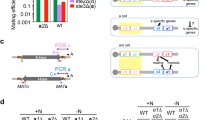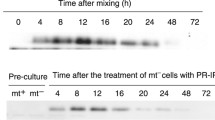Abstract
Cochliobolus heterostrophus has alternate genes (MAT-1 and MAT-2) at its mating-type locus. Transformants of a MAT-1 or a MAT-2 strain carrying a transgene of opposite mating type can self and are dual maters; the transgene, however, promotes development of pseudothecia only, not ascospores. To determine if the resident gene interferes with the function of the transgene, transformation vectors were designed to delete different amounts (2.5 kb, 5.7 kb, and 6.3 kb) of DNA at the MAT locus. Deletions occurred at a higher frequency (about 90% of transformants) with linearized plasmid than with circular plasmid (about 15% of transformants), and all three vectors were equally efficient at gene replacement. Both MAT-1 and MAT-2 could be deleted with the same set of vectors. Re-transformation of deletion strains (regardless of deletion size) with a wild-type copy of MAT restored full mating ability, indicating that the resident MAT gene interferes with function of the MAT transgene. Moreover, sexual development was normal whether the MAT transgene integrated at the homologous or at an ectopic site.
Similar content being viewed by others
Author information
Authors and Affiliations
Additional information
Received: 20 December 1994/3 August 1995
Rights and permissions
About this article
Cite this article
Wirsel, S., Turgeon, B. & Yoder, O. Deletion of the Cochliobolus heterostrophus mating-type (MAT ) locus promotes the function of MAT transgenes. Curr Genet 29, 241–249 (1996). https://doi.org/10.1007/s002940050042
Issue Date:
DOI: https://doi.org/10.1007/s002940050042




